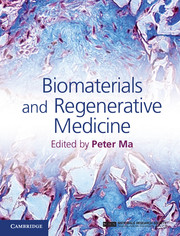Book contents
- Frontmatter
- Contents
- List of contributors
- Preface
- Part I Introduction to stem cells and regenerative medicine
- Part II Porous scaffolds for regenerative medicine
- Part III Hydrogel scaffolds for regenerative medicine
- 14 Polysaccharide hydrogels for regenerative medicine applications
- 15 Functionalized poly(ethylene glycol) hydrogels for controlling stem cell fate
- 16 Fumarate-based hydrogels in regenerative medicine applications
- 17 Hydrogel scaffolds for regenerative medicine
- 18 Microfabricated gels for tissue engineering
- 19 Organ printing
- Part IV Biological factor delivery
- Part V Animal models and clinical applications
- Index
- References
19 - Organ printing
from Part III - Hydrogel scaffolds for regenerative medicine
Published online by Cambridge University Press: 05 February 2015
- Frontmatter
- Contents
- List of contributors
- Preface
- Part I Introduction to stem cells and regenerative medicine
- Part II Porous scaffolds for regenerative medicine
- Part III Hydrogel scaffolds for regenerative medicine
- 14 Polysaccharide hydrogels for regenerative medicine applications
- 15 Functionalized poly(ethylene glycol) hydrogels for controlling stem cell fate
- 16 Fumarate-based hydrogels in regenerative medicine applications
- 17 Hydrogel scaffolds for regenerative medicine
- 18 Microfabricated gels for tissue engineering
- 19 Organ printing
- Part IV Biological factor delivery
- Part V Animal models and clinical applications
- Index
- References
Summary
Introduction
Since the first successful organ transplantation with a kidney in 1954 [1], scientists have maintained the dream of being able to fabricate organs on request. Organogenesis – or the creation of organs from artificial manipulation of cells, materials, growth factors (GFs), and other organ elements – has been waiting for the appropriate technology to emerge. This futuristic technique should be capable of rebuilding the compositional and structural complexities of human tissues and organs. The recent development of bioprinting technologies (defined by their high resolution and high-speed construction) has revived interest in applying those emerging methods for organogenesis. The term “organ printing” has become standard since the 2000s [2–4]. It refers to the line of investigations related to the development of the technologies for the construction of three-dimensional (3D) structures based on the deposition of different cell lines and biochemical promoters.
Although individual tissue systems have been successfully engineered for various applications using the basic tissue engineering approach, the means for the building of complex tissues that consist of multiple cell and tissue components have not been established. This is due to various challenges encountered in the tissue building process. One of the challenges has been the inability to recreate the well-defined cellular configurations and functions of a native tissue. Living tissues contain multiple cell types and various extracellular materials arranged in specific patterns that are difficult to replicate in vitro. Thus, one important goal of tissue engineering and regenerative medicine is to develop a tissue fabrication method that allows specific control over the placement of various cells and matrices in three dimensions in order to mimic the complexity of native tissue architecture. Emerging “organ printing” or “bioprinting” methodologies are being investigated in order to create tissue-engineered constructs that initially have more defined spatial organization. The underlying hypothesis is that with these biomimetic patterns one can achieve improved therapeutic outcomes [5].
- Type
- Chapter
- Information
- Biomaterials and Regenerative Medicine , pp. 332 - 374Publisher: Cambridge University PressPrint publication year: 2014
References
- 1
- Cited by



